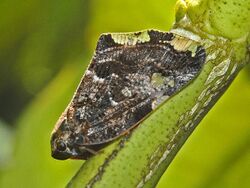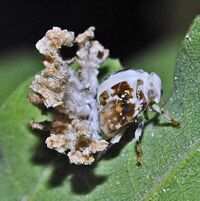Biology:Ricania speculum
| Ricania speculum | |
|---|---|

| |
| Ricania speculum on citrus. Dorsal view | |

| |
| Lateral view | |
| Scientific classification | |
| Domain: | Eukaryota |
| Kingdom: | Animalia |
| Phylum: | Arthropoda |
| Class: | Insecta |
| Order: | Hemiptera |
| Suborder: | Auchenorrhyncha |
| Infraorder: | Fulgoromorpha |
| Family: | Ricaniidae |
| Genus: | Ricania |
| Species: | R. speculum
|
| Binomial name | |
| Ricania speculum (Walker, 1851)
| |
| Synonyms[1] | |
| |
Ricania speculum, common name Black planthopper or Ricaniid Planthopper, is a species of planthoppers belonging to the family Ricaniidae.[2]
This species is considered a major agricultural pest for several crops in tropical and subtropical areas (apples, coffee plants, oil palms, Citrus species, etc.).[3][4][5][6]
Distribution and habitat
This species is widespread in China, India, Indonesia, Japan, Korea, Philippines and Vietnam. Recently, it has been accidentally introduced in northern Italy, possibly with ornamental plants or crops.[7][8] This species can be found in the low-elevation mountains and prefers dark environments.[9]
Description
Ricania speculum can reach a length of about 8 millimetres (0.31 in), with a wingspan of about 15 millimetres (0.59 in). These planthoppers have dark brown wings with central wavy horizontal bands and irregular transparent patches of different sizes.[9][10] The precostal area of the forewings shows dense transverse veinlets and the costal margin is distinctly convex near the base.[4] In males the tip of the abdomen is pointed, while in females is rounded. The final instar nymphs are white with dark brown markings and waxy secretions on the abdomen.[11]
Biology
These insects feed on sap that they suck from the leaves of the host plants. Ricania speculum has a single generation per year. The eggs overwinter in the bark of the branches waiting for the spring hatching.
References
- ↑ Catalogue of life
- ↑ Encyclopedia of life
- ↑ Biosecurity Australia (2008) Issues paper for the import risk analysis for fresh apple fruit from the People’s Republic of China Australian Government, Department of Agriculture
- ↑ 4.0 4.1 Cui-Ping Bu and Ai-Ping Liang First Record of the Genus Aprivesa Melichar (Hemiptera: Fulgoromorpha) from South India, with Description of One New Species
- ↑ Dennis S. Hill Agricultural Insect Pests of the Tropics and Their Control
- ↑ Dennis S. Hil Pests of Crops in Warmer Climates and Their Control
- ↑ FLOW Website
- ↑ Giuseppe Mazza, Fabrizio Pennacchio, Elisabetta Gargani, Italo Franceschini, Pio Federico Roversi e Fabio Cianferoni First report of Ricania speculum (Walker, 1851) in Europe (Hemiptera: Fulgoromorpha: Ricaniidae) Zootaxa, vol. 3861, nº 3, Magnolia Press
- ↑ 9.0 9.1 Ricania speculum at gaga.biodiv.tw
- ↑ Project Noah
- ↑ E. Rossi, A. Lucchi The Asian planthopper Ricania speculum (Walker) (Homoptera: Ricaniidae) on several crops in Italy
- Lin Jiang, Zhang Ya-Lin e Wang Ying-Lun A comparative study on the female reproductive system of four species of the Fulgoroidea (Hemiptera) Acta zootaxonomica Sinica, vol. 36, nº 3, Pechino, Beijing Kexin Printing Co., Ltd., 2011
Wikidata ☰ Q10654787 entry
 |


